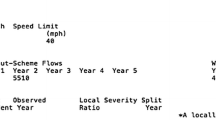Abstract
This article identifies factors that encourage or reduce pick-pocketing at underground rail stations through a case study analysis of the London Underground. Negative binomial Poisson regression models found predictor variables of pick-pocketing selected from the internal characteristics of stations and features of their nearby surroundings. Factors that increased risk were those associated with greater congestion inside stations including lifts, waiting rooms and fewer platforms; and increased levels of accessibility near stations, more paths and roads. Features that reduced risk were those likely to encourage detection and guardianship; stations with more personal validators, staffing levels and shop rentals; and the presence of more domestic buildings nearby. Station type was also influential; those that were ‘attractors’ of crime and those frequently used by tourists were at greater risk. The findings suggest a transmission of theft risk between the internal settings of underground stations and their nearby surroundings.
Similar content being viewed by others
References
Bernasco, W. and Block, R. (2011) Robberies in Chicago: A block-level analysis of the influence of crime generators, crime attractors, and offender anchor points. Journal of Research in Crime and Delinquency 48 (1): 33–57.
Block, R. and Block, C. (2000) The Bronx and Chicago: Street robbery in the environs of rapid transit stations. In: V. Goldsmith, P. McGuire, J. Mollenkopf and T. Ross (eds.) Analyzing Crime Patterns; Frontiers of Practice. Thousand Oaks, CA: Sage Publications, pp. 137–152.
Bowers, K. (2013) Risky facilities: Crime radiators or crime absorbers? A comparison of internal and external levels of theft. Journal of Quantitative Criminology. Advance Access 28 September, doi: 10.1007/s10940-013-9208-z.
Brantingham, P. and Brantingham, P. (1993) Environment, routine and situation: Toward a pattern theory of crime. In: R. Clarke and M. Felson (eds.) Routine Activity and Rational Choice: Advances in Criminological Theory. Vol. 5 New Jersey: Transaction Publishers, pp. 259–294.
Brantingham, P. and Brantingham, P. (1995) Criminality of place: Crime generators and crime attractors. European Journal on Criminal Policy and Research 3 (3): 5–26.
Browning, C. et al (2010) Commercial density, residential concentration, and crime: Land use patterns and violence in neighborhood context. Journal of Research in Crime and Delinquency 47 (3): 329–335.
British Transport Police (BTP). (2013) Statistical Bulletin 2012/13, http://www.btp.police.uk/pdf/Statistical-Bulletin-2013.pdf, accessed 4 August 2013.
Ceccato, V., Uittenbogaard, A. and Bamzar, R. (2013) Security in Stockholm’s underground stations: The importance of environmental attributes and context. Security Journal 26 (1): 33–59.
Clarke, R., Belanger, M. and Eastman, J. (1996) Where angels fear to tread: A test in the New York City subway of the robbery/density hypothesis. In: R. Clarke (ed.) Preventing Mass Transit Crime: Crime Prevention Studies. Vol. 6. Monsey, NY: Willow Tree Press, pp. 217–236.
Clarke, R.V.G. and Eck, J.E. (2003) Become a Problem Solving Crime Analyst in 55 Small Steps. London, UK: Jill Dando Institute, University College London.
Eck, J.E., Clarke, R.V. and Guerette, R.T. (2007) Risky facilities: Crime concentration in homogeneous sets of establishments and facilities. In: G. Farrell, K. Bowers, S.D. Johnson and M. Townsley (eds.) Crime Prevention Studies. Devon, UK: Willan.
Felson, M. and Cohen, L. (1980) Human ecology and crime: A routine activity approach. Human Ecology 8 (4): 389–406.
Groff, E. and McCord, E. (2012) The role of neighborhood parks as crime generators. Security Journal 25 (1): 1–24.
Groff, E., Weisburd, D. and Yang, S. (2010) Is it important to examine crime trends at a local ‘micro’ level? A longitudinal analysis of street to street variability in crime trajectories. Journal of Quantitative Criminology 26 (1): 7–32.
Hilbe, J.M. (2011) Negative Binomial Regression. New York: Cambridge University Press.
Jacobs, J. (1961) The Death and Life of Great American Cities. New York: Vintage Books.
Kurland, J., Johnson, S. and Tilley, N. (2013) Offenses around stadiums: A natural experiment on crime attraction and generation. Journal of Research in Crime and Delinquency 51 (1): 5–28.
La Vigne, N. (1996) Safe transport: Security by design on the Washington metro. In: R.V. Clarke (ed.) Preventing Mass Transit Crime. Monsey, NY: Criminal Justice Press, pp. 163–197.
Loukaitou-Sideris, A., Liggett, R. and Hiseki, I. (2002) The geography of transit crime: Documentation and evaluation of crime incidence on and around the Green Line stations in Los Angeles. Journal of Planning Education and Research 22 (2): 135–151.
MacDonald, J. and Lattimore, K. (2010) Count models in criminology. In: A. Piquero and D. Weisburd (eds.) Handbook of Quantitative Criminology. New York: Springer.
McCord, E., Ratcliffe, J., Garcia, R. and Taylor, R. (2007) Nonresidential crime attractors and generators elevate perceived neighborhood crime and incivilities. Journal of Research in Crime and Delinquency 44 (3): 295–320.
Newman, O. (1973) Defensible Space People and Design in the Violent City. London: Architectural Press.
Newton, A., Partridge, H. and Gill, A. (2014) Above and below: Measuring crime risk in and around underground mass transit systems. Crime Science 3 (1): 1–14.
Newton, A. (2014) Crime and public transport. In: D. Weisburd and G. Bruinsma (eds.) Encyclopedia of Criminology and Criminal Justice. New York: Springer-Verlag.
Osgood, D. (2000) Poisson-based regression analysis of aggregate crime rates. Journal of Quantitative Criminology 16 (1): 21–43.
Piza, E. and Kennedy, D. (2003) Transit stops, robbery, and routine activities: Examining street robbery in Newark, NJ Subway Environment, http://proceedings.esri.com/library/userconf/proc04/docs/pap1303.pdf, accessed 1 August 2013.
Rengert, G., Ratcliffe, J. and Chakravorty, S. (2005) Policing Illegal Drug Markets: Mapping the Socio-Economic Environments of Drug Dealing. New York: Criminal Justice Press.
Smith, M. (2008) Addressing the security needs of women passengers on public transport. Security Journal 21 (1–2): 117–133.
Smith, M. and Clarke, R. (2000) Crime and public transport. Crime and Justice: A Review of the Research 27 (6): 169–233.
Smith, M. and Cornish, B. (2006) Secure and Tranquil Travel: Preventing Crime and Disorder on Public Transport. London: UCL Jill Dando Institute of Crime Science.
Author information
Authors and Affiliations
Corresponding author
Rights and permissions
About this article
Cite this article
Newton, A., Partridge, H. & Gill, A. In and around: Identifying predictors of theft within and near to major mass underground transit systems. Secur J 27, 132–146 (2014). https://doi.org/10.1057/sj.2014.2
Published:
Issue Date:
DOI: https://doi.org/10.1057/sj.2014.2



